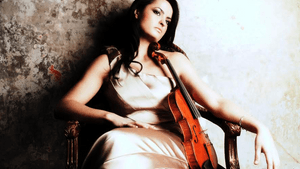Stay in the Loop
BSR publishes on a weekly schedule, with an email newsletter every Wednesday and Thursday morning. There’s no paywall, and subscribing is always free.
Three stunning premieres, two classics, one fine soloist
Chamber Orchestra of Philadelphia ends its 2015-2016 season

Is this what the Flyers call a hat trick? Dirk Brossé, music director of the Chamber Orchestra of Philadelphia, wasn’t content to conclude the season with a passionate performance of Mendelssohn’s Violin Concerto (with soloist Lana Trotovsek) and an exciting interpretation of Mozart’s Haffner Symphony.
Joining these two excellent reasons for coming to this season’s final concert was a trio of works by three living composers: not only living, but present in the Kimmel Center’s Perelman Theater to accept sincere applause and stay after the last whiff of Mozart to talk and answer questions about their work.
New music makes new admirers
Brossé, one of those composers, has a knack for encouraging new music and painlessly incorporating it into the Orchestra’s programs. On Sunday afternoon, he launched the program with the lush and lovely Venus and Adonis by Salvatore Di Vittorio. Di Vittorio is Brossé’s New York City equivalent, where he founded and conducts Gotham’s own Chamber Orchestra.
Receiving its world premiere this past weekend, the work recalls Respighi, with the Impressionist’s shimmer of sounds, gently highlighted by a dusting of cymbals, and caressing strum of the harp. However, it is infused with Di Vittorio’s own original imagination and ability to build, then deconstruct musical architecture that ultimately fades, like Venus’s own loveliness. And yet there is substance, an appealing heft to this work, which is perhaps why Di Vittorio, in a panel conversation after the concert, noted that Bach and Ravel were his greatest influences in this work. Take a look at the Titian painting that inspired it. This is no dreamy parting of lovers, but a passion that has ineradicable roots.
After a glorious interpretation of the Mendelssohn Violin Concerto (more about that shortly), Brossé introduced and conducted his own Echoes of Silent Voices, a single-movement violin concerto commemorating the losses of individual lives in the Holocaust. In its American premiere, the richly moody, melancholy, ultimately uplifting melodies poured from the orchestra and from the bow of soloist Lana Trotovsek, making a kind of sense of grief and acknowledging that some sorrows, like Wordsworth’s thoughts, are “too deep for tears.” A simple repetitive theme, which sounded to me like four 16th notes and a half note, is embraced by the orchestration and the pure singing tone of Trotovsek’s violin. One is left with a sense of monumentality overlaid by the single voice, the voice of the violin, the voice of each individual soul.
An abrupt but not disruptive change of pace came with a fresh new work by Nick DiBerardino, a Rhodes scholar and Curtis Institute student. Brossé announced that because "To the Colors" is so short (three minutes), the Orchestra would play it twice. “You will hear the world premiere,” he quipped, “and then be here for the second performance!” This is a dense, energetic, driven work, full of jostling and jarring tonal colors. They take a pronounced break of silence, crash together again and end on a solid tonic. I really enjoyed this work, and its length couldn’t have been better given the program’s ambitious scope. Playing a new work twice truly gave us the opportunity to understand and appreciate the music as it unfolded. During the post-program panel, DiBerardino said he was inspired by Mozart’s Haffner Symphony, and included a few hidden tributes to the Austrian master in the score.
A star blazed
The program concluded with a strong, forthright performance of Mozart’s Symphony #35 in D major. Although this is a chamber orchestra, it has a big sound, and sunk its musical teeth into this work with vigor and relish.
I save perhaps the best for last. The second work in the program, Mendelssohn’s Violin Concerto in E minor, unfolded magically under Brossé’s direction. His touch was gentler, more elegant with this familiar work. The orchestra held its own, and I noticed little solos I had not noticed before.
There was no doubt that beyond conductor and ensemble, a star blazed onstage: Lana Trotovsek, born in Slovenia, now a Londoner. She made the solo violin part her own, creating a bright, confident tone on the 1750 Dalla Costa instrument on loan from an anonymous benefactor. Poised and dignified in a Grecian-style gown, the artist brought freshness, depth, and insight to a work often heard on Philadelphia stages, hitting high notes with clarity and precision, but never succumbing to mere virtuosity. Well done, artists, a great conclusion to a memorable season.
What, When, Where
Chamber Orchestra of Philadelphia. Di Vittorio, Venus and Adonis. Mendelssohn, Violin Concerto in E minor, Op. 64. Brossé, Echoes of Silent Voices. DiBerardino, To the Colors. Mozart, Symphony No. 35 in D major, K. 385 ("Haffner"). Dirk Brossé, conductor. Lana Trotovsek, violin. May 15-16, 2016 at the Perelman Theater, Kimmel Center for the Performing Arts, Broad and Spruce Sts., Philadelphia. (215) 545-5451 or chamberorchestra.org.
Sign up for our newsletter
All of the week's new articles, all in one place. Sign up for the free weekly BSR newsletters, and don't miss a conversation.

 Linda Holt
Linda Holt